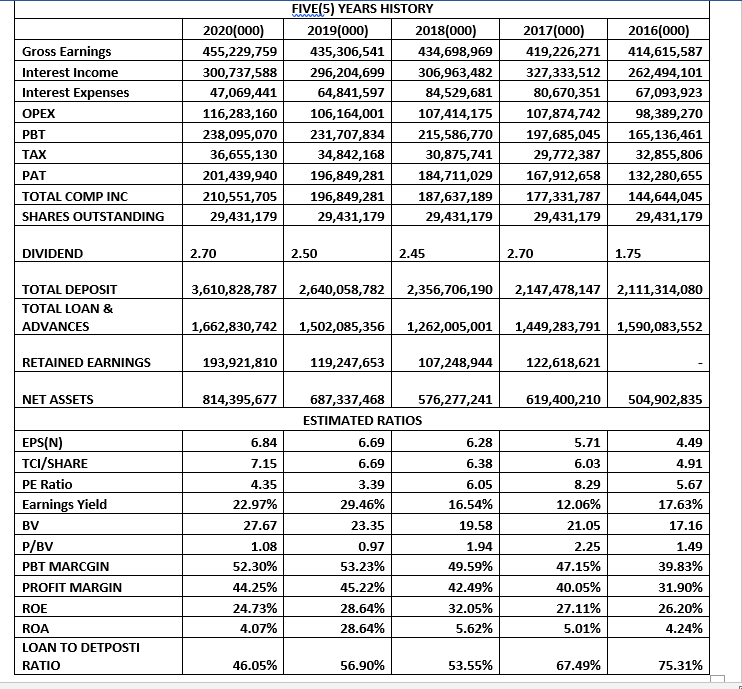HOW GTB BATTLED POTENTIAL SPOILERS IN 2020

With Strong Profit Margin and industry lowest Cost to income metrics , GTB still retains its laurel as the most efficient bank .
The year 2020,indeed , was tough . With the COVID-19 induced macroeconomic challenges hard felt by the banking sector, the year became a metaphorical hard nut . But necessity ,they say , is the mother of inventions , to survive the deleterious environment and locate the mother lodes , some banks truly fought back . GTB , the industry most valuable bank , was undeterred ; it became resilient and navigated the hard terrain with iron teeth .After interplay of forces , GT bank’s result for FY2020 showed top and bottom-line earnings resilience ; it is still the most efficient bank with the lowest cost to income so far .

A review of the result shows improved performance across all key financial metrics reflecting the quality of past decisions and reaffirming its position as one of the best managed financial institutions in Africa. Gross earnings of the group grew marginally in 2020, despite macroeconomic challenges in the year . Earnings grew Y-o-Y by +4.58% from N435.31bn in 2019 to N455.23bn in 2020. . But GTB showed that it’s not what you get but what you make out of it that matters. To achieve this feat , it wrenched up bottom line with a deft application of management’s experience beginning from leveraging net interest income ; the management hauled up its net interest income . Though its interest income ,threatened to spoil the bank’s efforts coming down by 1.2 % , however, after suppressing interest expenses by 27.41% , its net interest income [NII ] got a 9.64% Y-o-Y uptick and a major driver of gross earnings . By this effort , Net interest income, a guide to how well a bank manages the interest rates it pays for borrowing and lending, contributed heavily to give to a positive outlook to pre-tax profit.
Not only that , impairment charges on loans, constituted another potential spoiler ; it significantly increased Y-o-Y by 298.50 50% from N4.91bn in 2019 to N19.57bn in 2020 . The banking group’s impairment charge to loan ratio was 1.18% in 2020 against 0.33% in 2019. However as noted in the lender’s FY 2020 presentation, “70% of the increase in the loan impairment charge in 2020 was due to the Bank’s decision to increase the level of provisioning on one of its Obligors owing to the impact of worsening macros on the company’s operations and financial condition. Also, increased Probability of Default (PD) from the devaluation of the Naira to US$ led to an uptick in the impairment charge”. This significant jump in impairment put pressure on income relative to the comparative period
The above impairment upsurge could be linked to elevated risk environment However, the bank’s maturity transformation activity or ability to wring gains from interest bearing assets which ,the core competence of the bank , rescued the uninspiring run . The Group’s Loan book (Net) grew by 10.7% from ₦1.502trillion recorded as at December 2019 to ₦1.663trillion in December 2020. This did not endanger the bank’s fortunes as the bank’s deposit grew faster than its loans .
The bank has been taken a path of caution in the last few years now situating this on the increasing prevailing risk sensitive environment and rate of deposit movements . A detailed observation of this bank revealed the group’s loan-to-deposit ratio (LDR) in the last five years has spiralled downwards, the percentage growth in total deposits has been higher than the percentage growth in total loans and advances. LDR declined from 57.03% in 2019 to 46.05% in 2020 which was lower than the regulatory minimum of 65%. A key growth driver of risk assets was the 10.81% growth in loans and advances to customers while loans and advances to banks dropped by 93.46% in 2020 .Also, growth in total deposits was spurred by a 38.57% increase in deposits from customers while deposits from banks declined by b5.59% in 2020 . Even with low LDR GTB, non performing loans still proved stubborn . But the management’s efforts to control the situation paid off a bit . The non-performing loan ratio (NPL) in 2020 improved slightly to 6.39% from 6.53% in 2020. Improvement in the NPL ratio in 2020 was attributed to strengthened controls around loan performance by identifying vulnerable sectors with heightened PDs and put in measures to minimize default as stated in the financials of the bank.
But surprisingly , the result also showed a bank that is paying more attention to interest bearing activities than commission yielding businesses as net fee and commission income slid by 21.04% . This decline was attributed to the 109.88% increase in fee and commission expenses and a 14.80 % slide in fee and commission income. E-banking income slumped by 24.85% in 2020 while bank charges under fee and commission expenses grew by 128.98 % . Also, a driver of the increase in fee and commission expenses, loan recovery expenses grew by 81.74% in 2020. Moreover, the devaluation of the naira in 2020 did the bank no favours as dollar-denominated earnings took a knock. In the future, the bank will need to rev up its non interest dependent transactions for better performance .
In spite of the above challenges ,however , the bank’s maturity transformation competence delivered the goodies against the rising tides from low yield and high risk environment .The bank that is best-positioned to outperform in the long run will have the capacity to innovate and reinvent around new business models that combine both human and technological capabilities. The fate of an organization is not predetermined by the industry in which it operates. By fostering the organizational capacity for innovation and reinvention, companies in all sectors can achieve vitality and thrive sustainably. This is reflected in the bank’s ability to restrict operational expenses and cut massively its interest expenses that consequently enabled its net interest income to jump many paces and helped it to deliver high profitability and retain its efficiency leadership . This gives a sense that the bank is earning more from interest income than it is expending on interest expenses.
The bank has consistently been Nigeria’s most cost-efficient lender over the last five years and remains so even though pressure has been put on operational cost in 2020 . The ability of the bank to restrict its operational expenses to 9.53 % impacted positively on bottom line and gave its pre tax a positive outlook . Profit before tax grew marginally Y-o-Y by 2.76% from N231.71bn in 2019 to N238.09bn in 2020 After the inter play of incomes and costs the bank’s cost-to-income ratio settled at the Group’s cost-to-income ratio settled at 38.24% in 2020 . This is still below its 2020 guidance of 40% and best in the industry . This impacted on its pre tax margin valued at 52.30%, the best in the industry . Another demonstration of its efficiency skill was in its interest expense which was the same as 10.34% of the Gross Earnings through the year, a lower and better performance, when compared to the 14.90% recorded in the prior full-year. To cement its place as the most efficient bank and achieve more with less , its return on equity (ROE), and return on assets (ROA) remain the industry best . It achieved a Post-Tax Return on Equity (ROAE) of 26.8% while its Post-Tax Return on Assets (ROAA) stood at 4.6% .
GTB is ,no doubt , investors friendly . In spite of the tough terrain and its associated challenges ,at the end of 2020 full-year, the bank’s board announced a final cash dividend of N2.70 per share, an improvement over the previous N2.50 payout. The final dividend is in addition to the 30 kobo paid as an interim dividend at half-year, bringing the total payout to N3.00 each. Estimates reveal that the said final dividend represents 39.45% of total earnings, fairly in agreement with the 37.38% payout ratio of 2019. As of the time the result was released, the dividend amounted to 9.06% of the total value of GT Bank’s shares on the exchange, which we believe is a better yield when compared to most fixed income investment instruments .
GTB’s earning power has remained a major driver of its stock value . At the end of the period under review, the management of GTBank earned N6.84 per unit, a mild improvement over that of the corresponding year’s earnings of N6.69 each. P/E-Ratio for full-year is put at 4.35x, up from 3.39x in the corresponding year , showing investors are ready to pay more to have more shares of its stock . . Meanwhile, confirming the attractiveness of GTBank’s shares at the moment is the fact that the said earnings yielded 22.97% of the current market price, though below the 29.46% yield recorded in the comparable year of 2019. This is still an outstanding yield. Presently, the estimated Book Value of the bank stemmed below our intrinsic value at N27.67, an improvement over the N23.35 estimated in 2019.
The year 2020 was tough and the COVID-19 induced macroeconomic challenges were hard felt by the banking sector. However, the share price performance and the banking sector index both recorded an increase in the year despite the challenges. GTBank’s share price movement in 2020 reflects the volatility faced in the business cycle in 2020, March 2020 records the lowest levels of the share price of the bank at N17.7. At the tail end of the year share price had improved with which was supported by the gradual reopening of the economy and business activities. The share price of the financial institution increased higher than the pre-COVID-19 levels, closing the year at 8.92% higher
Guaranty Trust Bank’s Balance sheet remained well structured, diversified and resilient with Total assets and Shareholders’ Funds closing at ₦4.945trillion and ₦814.4billion respectively. Full Impact Capital Adequacy Ratio (CAR) remained very strong, closing at 21.9%, while Asset quality was sustained as NPL ratio and Cost of Risk (COR) closed at 6.4% (Bank: 5.9%) and 1.2% (Bank: 1.0%) in December 2020 from 6.5% (Bank: 6.2%) and 0.3% (Bank: 0.2%) in December 2019 respectively.
Commenting on the financial results, the Managing Director/CEO of Guaranty Trust Bank plc, Mr. Segun Agbaje, said; “2020 was arguably the most challenging year that the world has faced in decades. In such unprecedented times, we sought to live out the full extent of our values; safeguarding lives and livelihoods for our people, our customers and across the communities where we operate. We were on solid footing going into 2020; the strength, scale and liquidity of our balance sheet, coupled with the quality of our past decisions and the efficacy of our digital-first customer-centric strategy gave us the resilience and flexibility to navigate the economic shocks and market volatility that dominated the year.”







